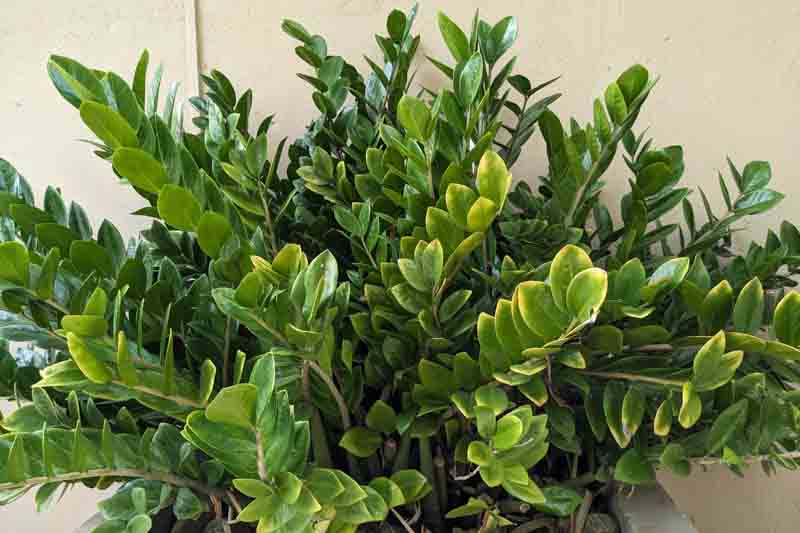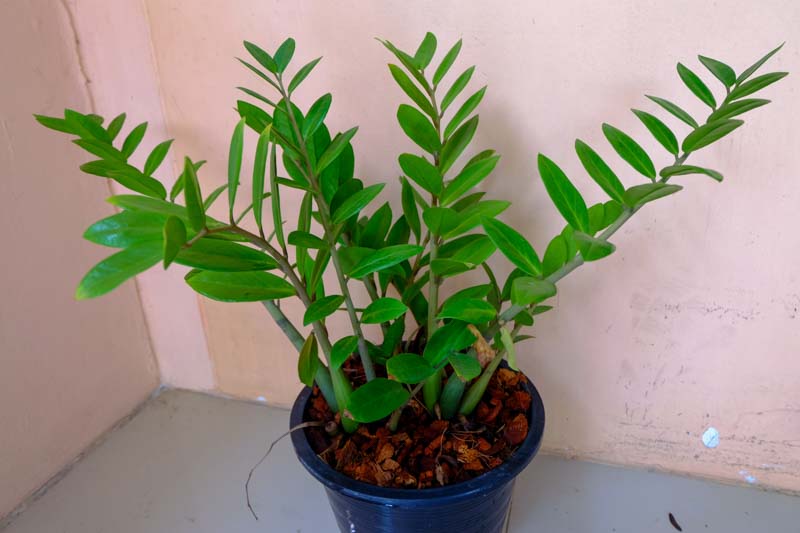ZZ Plant, Fern Arum, Zanzibar Gem
Zamioculcas zamiifolia, or ZZ Plant, stands out for its elegant foliage, ease of care, and adaptability, making it a favored choice for adding greenery to indoor spaces. Its resilience to neglect and ability to purify the air are added benefits that make this plant a valuable addition to any plant collection.
Zamioculcas zamiifolia, commonly known as the ZZ plant, is a tropical perennial known for its striking, glossy foliage and robust nature. This plant has become a staple in the houseplant community due to its ability to thrive under minimal care. It’s characterized by its thick, waxy leaves that grow on stems that can store water, making it highly drought-tolerant.
Native: The ZZ plant is native to the arid regions of eastern Africa, ranging from Kenya south through northeastern South Africa. It thrives in low-light conditions and dry environments, mimicking its native habitat’s drought-prone conditions. It belongs to the arum family (Araceae), along with Zantedeschia (Calla Lily), Caladium (Angel Wing), Monstera (Swiss Cheese Plant), or Colocasia (Elephant Ear).
Plant Type and Habit: The ZZ Plant is a rhizomatous, evergreen plant that displays a unique aesthetic with its sleek, wand-like leaves that sprout from its base. It’s known for its slow-growing, upright habit, making it an ideal plant for indoor spaces.
Size: In its natural habitat, the ZZ plant can grow up to 2-3 feet tall and wide (60-90 cm). However, when grown indoors, its size is often limited by the pot size and the environment, typically reaching heights of 2 feet (60 cm).
Flowers: The ZZ Plant flower is small, green and white, and arum-like. It is hidden at the base of its leaves, closer to the soil line, and less showy than the foliage. It is rarely produced when kept indoors. The flowers give way to small, white berries, but they are seldom seen outside their natural habitat.
Foliage: The foliage is the most striking feature of the ZZ plant, with its smooth, glossy, dark green leaves giving it a lush, vibrant appearance. The leaves are thick and succulent, capable of storing water to help the plant survive drought conditions. They arise directly from the ground and have six to eight pairs of leaflets, about 6 inches long (15 cm).
Hardiness: The ZZ plant is quite hardy, suitable for USDA zones 9-10 if planted outdoors. It’s primarily grown indoors where it can survive in a wide range of conditions, from low light to brighter spots.
Award: Recipient of the prestigious Award of Garden Merit of the Royal Horticultural Society.
Uses: The ZZ Plant is primarily used as an ornamental houseplant. Its tolerance for low light and neglect makes it a popular choice for both homes and offices. It’s also utilized in interior design, adding a touch of greenery to modern living spaces.
Drought: One of the plant’s standout features is its exceptional drought tolerance. Its rhizomes store water, allowing it to survive extended periods without water, making it an excellent plant for those who occasionally forget to water their plants.
Toxicity: It’s important to note that the ZZ plant is toxic if ingested. Its leaves and rhizomes contain calcium oxalate crystals, which can cause irritation and discomfort to pets and humans if chewed or swallowed.
Benefits: Beyond its aesthetic appeal, the ZZ plant is believed to have air-purifying qualities, contributing to a healthier indoor environment by removing volatile organic compounds (VOCs) from the air.

Caring for a ZZ Plant involves simple steps that make it one of the most low-maintenance houseplants available.
Light: ZZ Plants prefer bright, indirect light but can tolerate low light conditions. Avoid direct sunlight, which can scorch the leaves.
Soil: Use a well-draining potting mix. A mix designed for cacti and succulents works well for ZZ Plants because it ensures excess water drains quickly.
Water: Water your ZZ Plant when the top inch of soil feels dry. Overwatering can lead to root rot, so ensure the pot has good drainage. These plants are drought-tolerant and can survive periods without water.
Temperature and Humidity: ZZ Plants thrive in a wide range of temperatures, ideally between 60-75°F (15-24°C). They do well in average home humidity levels but can tolerate lower humidity without issue.
Fertilization: Fertilize your ZZ Plant with a balanced, water-soluble fertilizer diluted to half strength once every 6 months to a year. Over-fertilization can harm the plant, so it’s better to under-fertilize than overdo it.
Pruning: Pruning is rarely needed but can be done to remove any yellowing or dead leaves. Use clean, sharp scissors to cut any unhealthy foliage at the base.
Repotting: ZZ Plants grow slowly and rarely need repotting. Consider repotting every 2-3 years or when the plant becomes root-bound. When repotting, choose a pot that is only one size larger than the current one to avoid overwatering.
Propagating a ZZ Plant is a straightforward process that can be done using stem cuttings or division.

The ZZ Plant is relatively resistant to major problems, but like all indoor plants, it can encounter some pests, diseases, and common issues.
Spider Mites: These tiny pests can be identified by the fine webs they weave on the plant. They cause yellowing or speckled leaves. Increase humidity around the plant and wash it with a strong stream of water. For severe infestations, use insecticidal soap or neem oil.
Mealybugs: These white, cottony pests tend to cluster in leaf axils and under leaves, sucking sap and weakening the plant. Remove with alcohol-dipped cotton swabs or apply neem oil.
Aphids: Small, soft-bodied insects that can be green, black, brown, or pink, aphids typically feed in groups on the undersides of leaves. Combat them with a gentle spray of water, neem oil, or insecticidal soap to protect the plant’s health and appearance.
Scale insects: Hard or soft-bodied insects that attach themselves to the stems or leaves, causing yellowing and growth stunting. Scrape off with a fingernail or use a cotton swab dipped in rubbing alcohol. Insecticidal soap or neem oil may also be used.
Root rot: Overwatering is the primary cause, leading to brown, mushy roots and yellowing leaves. Reduce watering, improve drainage, and repot the plant into fresh, well-draining soil. Severely affected roots should be trimmed before repotting.
Leaf spot: Fungal or bacterial infections can cause dark or black spots on leaves, often with a yellow halo. Increase air circulation, avoid wetting leaves when watering, and remove affected leaves. Fungicides or bactericides may be necessary in severe cases.
Yellow Leaves
Often a sign of overwatering but can also indicate too much direct sunlight. Adjust watering habits and relocate the plant to a spot with bright, indirect light.
Brown Leaf Tips or Edges
Usually a sign of low humidity or watering with tap water high in fluoride or chlorine. Increase humidity around the plant or switch to distilled or rainwater.
Slow Growth or No New Growth
ZZ Plants grow slowly, especially in low-light conditions. Ensure the plant receives adequate light and consider fertilizing with a balanced, water-soluble fertilizer during the growing season if necessary.
Yes, ZZ Plants (Zamioculcas zamiifolia) are toxic to cats. They contain calcium oxalate crystals, which can cause irritation to the mouth, tongue, and throat if ingested. Symptoms of ingestion may include drooling, vomiting, and difficulty swallowing. It’s important to keep ZZ Plants out of reach of pets and to consult a veterinarian if you suspect your cat has chewed on or ingested any part of the plant.
ZZ Plants require relatively infrequent watering due to their drought-tolerant nature. The frequency of watering will depend on factors like the light conditions, the pot size, and the ambient humidity, but a general rule is to water when the top 1-2 inches of soil have dried out. This might translate to watering every 2-3 weeks, but it’s crucial to adjust based on the plant’s environment and season. During winter, the plant may require even less frequent watering.
Yellow leaves on ZZ Plants often indicate overwatering, which can lead to root rot. Ensure the plant is in well-draining soil and water only when the top few inches of soil are dry. Underwatering, excessive light, or nutrient deficiencies can also cause yellowing. Adjust care accordingly to prevent further issues.
| Hardiness |
9 - 10 |
|---|---|
| Plant Type | Houseplants, Perennials |
| Plant Family | Araceae |
| Common names | ZZ Plant |
| Exposure | Partial Sun, Shade |
| Season of Interest |
Spring (Early, Mid, Late) Summer (Early, Mid, Late) Fall Winter |
| Height |
2' - 3' (60cm - 90cm) |
| Spread |
2' - 3' (60cm - 90cm) |
| Maintenance | Low |
| Water Needs | Average |
| Soil Type | Loam, Sand |
| Soil pH | Acid, Neutral, Alkaline |
| Soil Drainage | Well-Drained |
| Characteristics | Showy, Evergreen, Plant of Merit |
| Tolerance | Full Shade, Drought |
| Garden Uses | Patio And Containers |
| Hardiness |
9 - 10 |
|---|---|
| Plant Type | Houseplants, Perennials |
| Plant Family | Araceae |
| Common names | ZZ Plant |
| Exposure | Partial Sun, Shade |
| Season of Interest |
Spring (Early, Mid, Late) Summer (Early, Mid, Late) Fall Winter |
| Height |
2' - 3' (60cm - 90cm) |
| Spread |
2' - 3' (60cm - 90cm) |
| Maintenance | Low |
| Water Needs | Average |
| Soil Type | Loam, Sand |
| Soil pH | Acid, Neutral, Alkaline |
| Soil Drainage | Well-Drained |
| Characteristics | Showy, Evergreen, Plant of Merit |
| Tolerance | Full Shade, Drought |
| Garden Uses | Patio And Containers |
How many Zamioculcas zamiifolia (ZZ Plant) do I need for my garden?
| Plant | Quantity | |
|---|---|---|
| Zamioculcas zamiifolia (ZZ Plant) | N/A | Buy Plants |
Create a membership account to save your garden designs and to view them on any device.
Becoming a contributing member of Gardenia is easy and can be done in just a few minutes. If you provide us with your name, email address and the payment of a modest $25 annual membership fee, you will become a full member, enabling you to design and save up to 25 of your garden design ideas.
Join now and start creating your dream garden!
Create a membership account to save your garden designs and to view them on any device.
Becoming a contributing member of Gardenia is easy and can be done in just a few minutes. If you provide us with your name, email address and the payment of a modest $25 annual membership fee, you will become a full member, enabling you to design and save up to 25 of your garden design ideas.
Join now and start creating your dream garden!